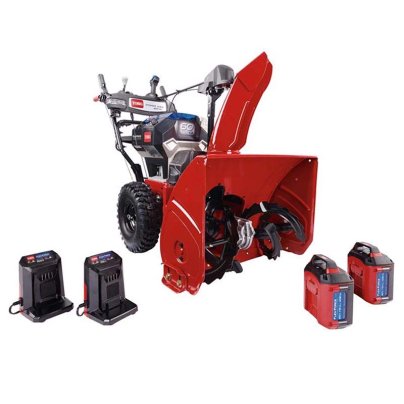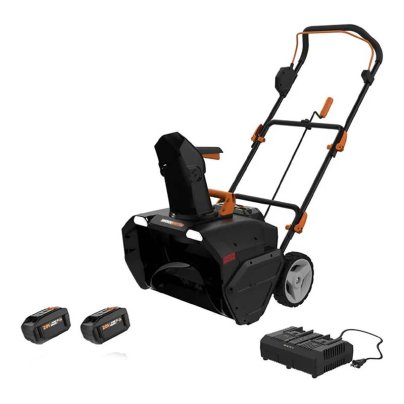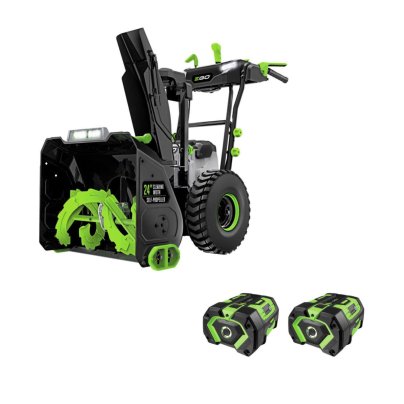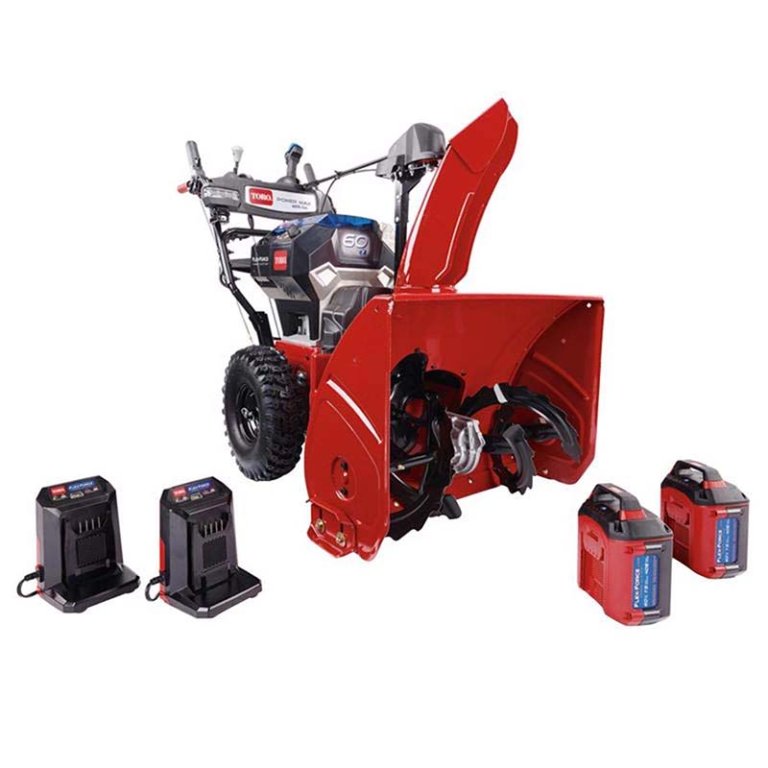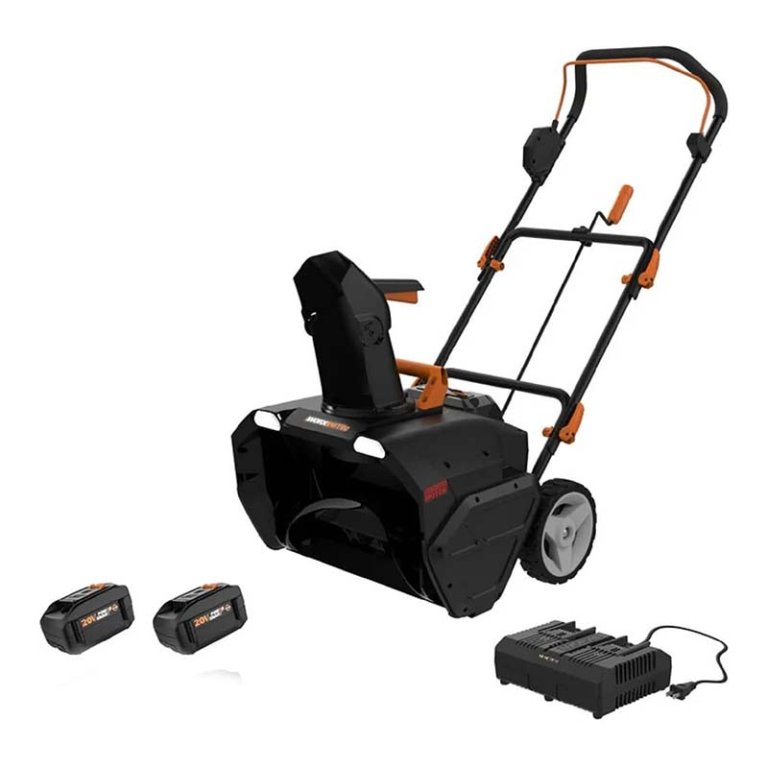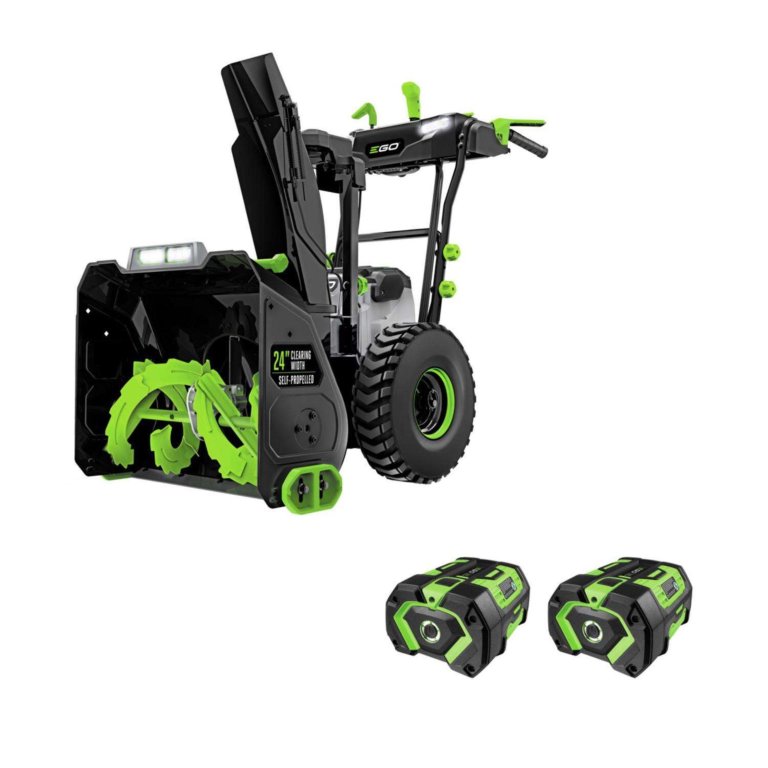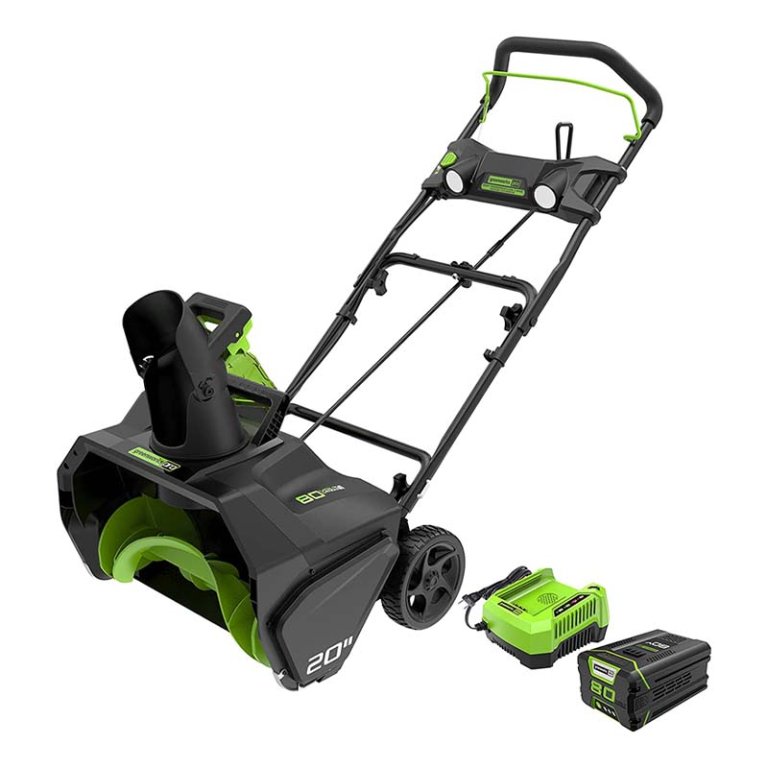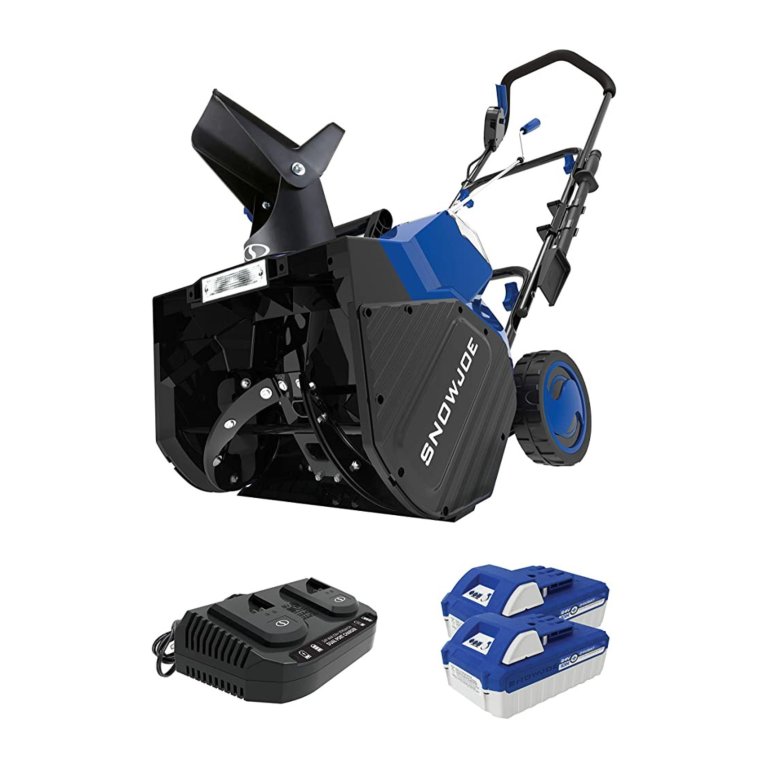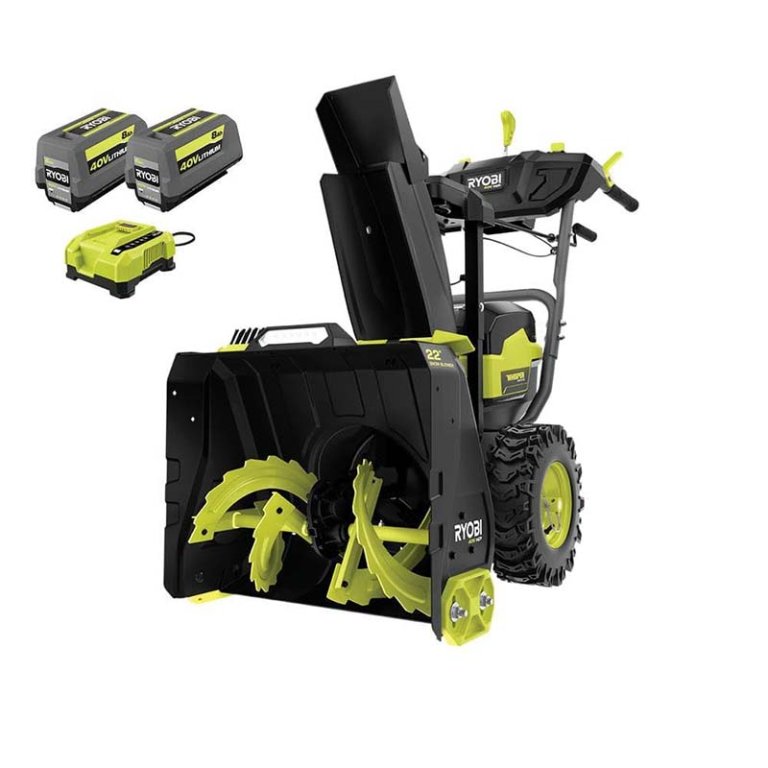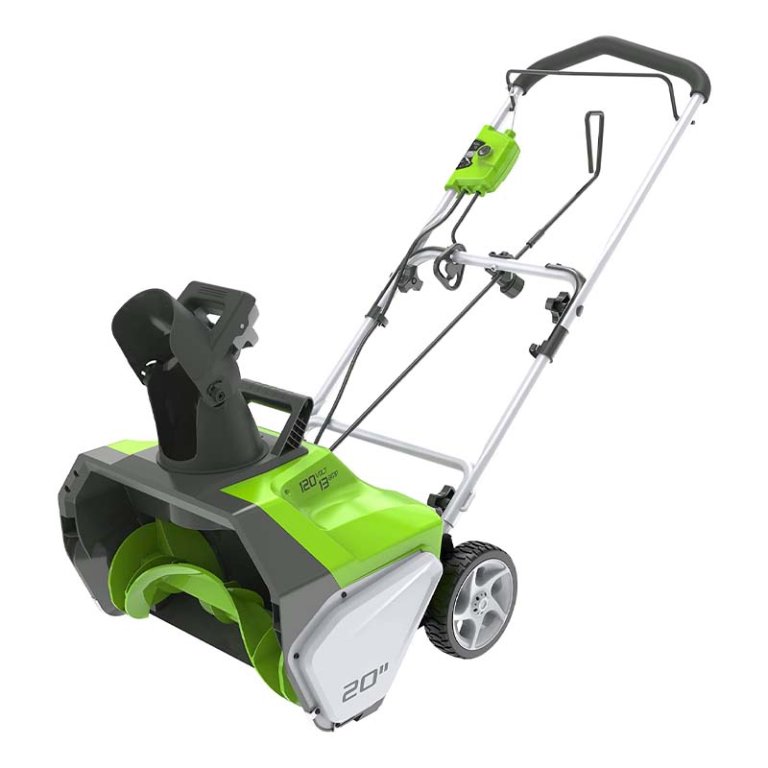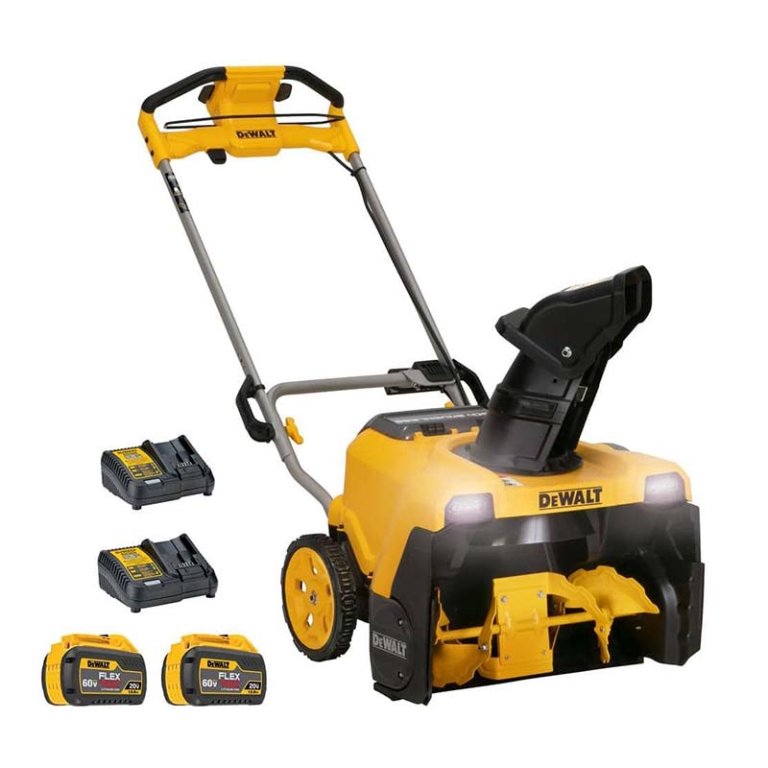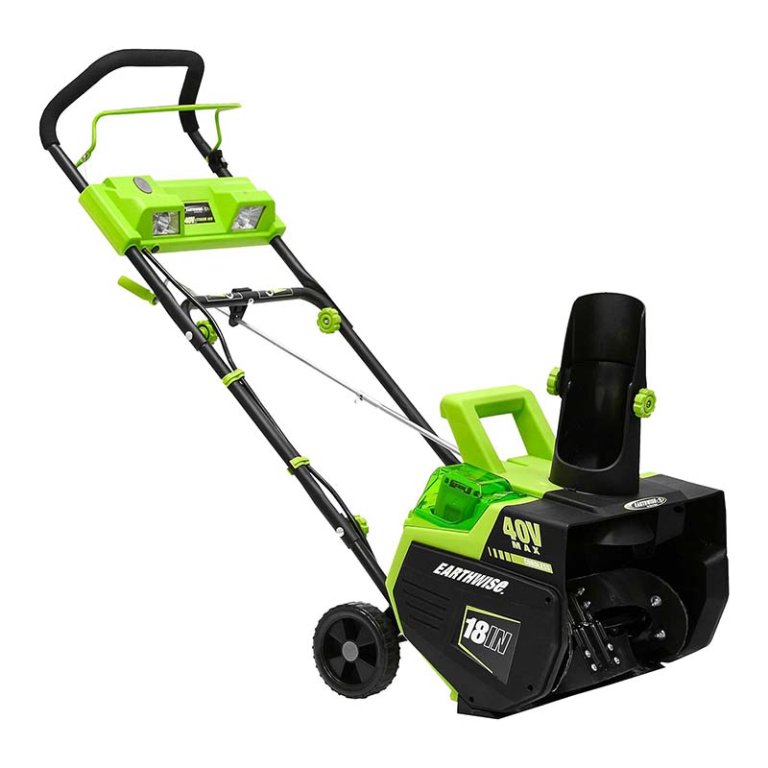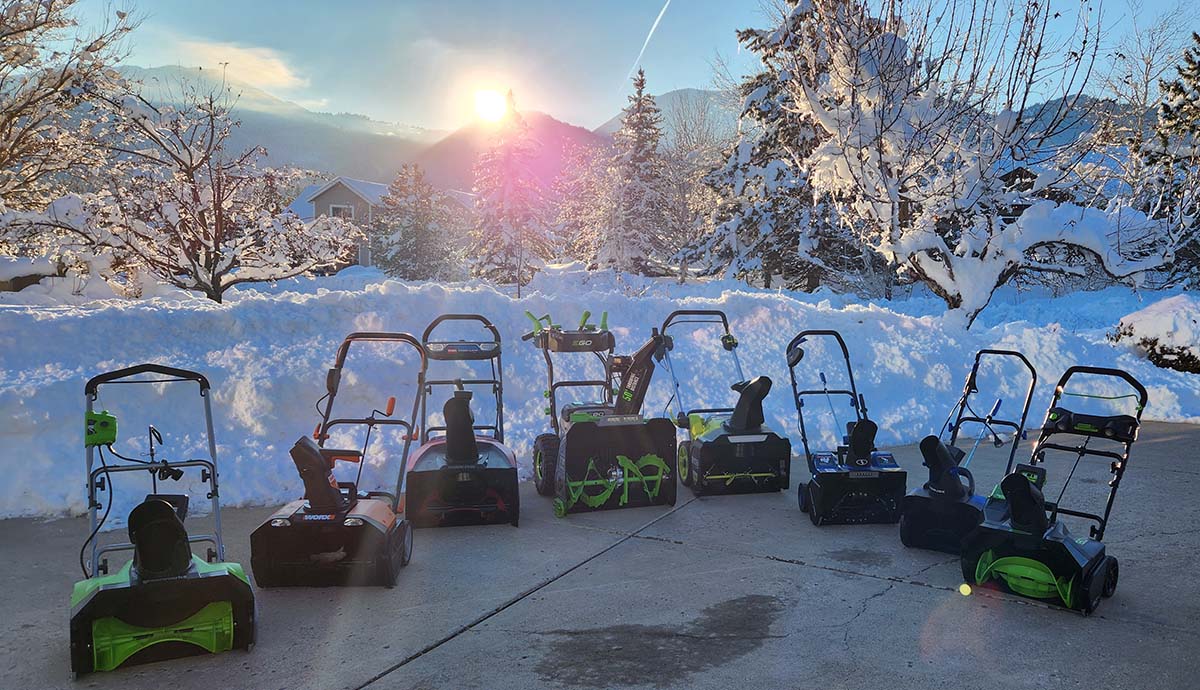
We may earn revenue from the products available on this page and participate in affiliate programs. Learn More ›
Electric snow blowers offer a reprieve from the time-consuming hassle of shoveling and the maintenance and fumes that come with using gas-powered blowers. The convenient single-stage, two-stage, and three-stage tools are available in corded and cordless options to accommodate various amounts and types of snowfall. Because there are so many different models to choose from, we researched and tested a number of popular electric snow blowers, rating them based on performance, ease of use, size, and value.
We completed our hands-on tests under a variety of conditions, clearing more than 24 inches of snow during a massive 4-day storm in the Lake Tahoe region. We also spoke with a representative from Blain’s Farm & Fleet to get expert insights on the advantages and disadvantages of these machines. Based on their expertise and our test results, we chose the Toro Power Max e24 60V Two-Stage Snow Blower as our best overall pick. Its 24-inch plowing width, two 6 amp hour batteries, and heavy-duty steel auger deliver excellent performance rivaling that of powerful gas snow blowers.
Read on to see how these tools performed clearing all sorts of snow, including powdery, ice-crusted, and heavy wet snow. For additional information on how to choose the best electric snow blowers, review our shopping considerations at the end of this guide.
- BEST OVERALL: Toro Power Max e24 60V Two-Stage Snow Blower
↓ Jump to Review - BEST BANG FOR THE BUCK: Worx Nitro 40V Power Share 20-Inch Snow Blower
↓ Jump to Review - BEST VERSATILITY: Ego Power+ 24-Inch Self-Propelled Snow Blower
↓ Jump to Review - MOST EFFICIENT BATTERY: Greenworks 80V 20-Inch Single-Stage Snow Blower
↓ Jump to Review - BEST FOR SMALL DRIVEWAYS: Snow Joe 24-V-X2-SB18 48-Volt Ionmax Snow Blower Kit
↓ Jump to Review - BEST FOR LARGE DRIVEWAYS: Ryobi 40V HP Brushless Whisper 22-Inch Snow Blower
↓ Jump to Review - BEST FOR OLDER ADULTS: Greenworks 13 Amp 20-Inch Corded Snow Blower
↓ Jump to Review - BEST NEWCOMER: DeWalt 60V MAX 21-Inch Single-Stage Snow Blower
↓ Jump to Review - ALSO CONSIDER: Earthwise 18-Inch 40V 4Ah Lithium Snow Thrower
↓ Jump to Review

Our Top Picks
Quality electric snow blowers can clear driveways, paths, patios, and decks in light or heavy snow. Made with the operator in mind, they are lightweight, have excellent maneuverability, and use LED lights to provide guidance in the dark. Below, we review some of the best electric snow blowers that stand out for their quality, ease of use, and effectiveness.
Best Overall
Toro Power Max e24 60V Two-Stage Snow Blower
What We Like
- Optional third battery bay extends runtime during big storms
- Eco mode saves power during light-duty jobs
- Solid and heavy-duty overall build
- Excellent traction, auger cutting, and snow throwing
What We Didn’t Like
- Heavier than many plastic-built models
- Too big for tight spaces and small jobs
Product Specs
- Type: 2-stage
- Width: 24 inches
- Power source: Two 6 amp hour (Ah) batteries
Toro brings all the benefits of heavy-duty gas snow blowers into the electric market with this serious two-stage design. It’s made to last with a substantial steel auger, box, and chute. We tested this on concrete and gravel, and it proved impressive in both environments. Since its geared design means it doesn’t have shear pins to manage or replace, it’s well suited to blowing snow over either smooth or rough terrain.
For small driveways and occasional use, a single-stage model with more plastic will be lighter and require less battery power. But for folks living in mountain regions and northern zones that see heavy snowfall, this Toro is an exceptional unit. During our tests, it easily cleared our large driveway on a single charge with its two batteries. It also has a third battery slot if you need to manage a larger area without having to recharge.
If you’re looking for an electric snow blower that must at least occasionally churn through heavy, wet snow dropped by big storms, this durable and capable unit is it. It even has a great headlight for dim conditions, which only adds to its capabilities.
What our tester says: “We found this unit’s overall power on par with gas models, and it held up well against a top-tier machine we also own in terms of traction and performance.”—Zach Lazzari, Product Reviews tester and writer
Best Bang for the Buck
Worx Nitro 40V Power Share 20-Inch Snow Blower
What We Like
- Great auger speed and maneuverability
- Throws snow up to 20 feet
- Lightweight and easy to push
What We Didn’t Like
- Not designed for more than 12 inches of snow
- Not self-propelled
Product Specs
- Type: Single-stage
- Width: 20 inches
- Power source: Two 20-volt (V) batteries for 40V total
On first appearance, the affordable Worx 40V 20-inch electric snow blower didn’t scream “power,” but during testing, it moved quickly through snow loads up to 12 inches deep. We were pleasantly surprised by its performance as we used it to clear a large deck, several pathways, and a midsize driveway.
Not only is the unit effective, it’s also easy to assemble and operate. Simply attach the multipiece handle with the included hardware, push the start button, and squeeze the leaver to power the auger. It has dual LEDs to light its path, and although we primarily used this model in daylight, our nighttime tests proved they’re able to illuminate a reasonable area. The 180-degree chute has a convenient lever to change directions, and it never jammed or stuck while operating.
You’ll need both batteries to operate this small snow blower, which, when combined, deliver a total of 40 volts for up to an hour. The unit features a dual charging port for simultaneous charging, and we ran the machine in 30-minute segments before recharging and never killed the battery. Be aware, however, that it only throws snow at a distance of twenty feet. While that’s ample for small to midsize areas, some folks might want something bigger for large spaces and deep snow. Overall, the Worx 20-inch snow blower provides great performance at a moderate price point.
Get the Worx electric snow blower at Amazon, Lowe’s, Walmart, Best Buy, or Worx.
Best Versatility
Ego Power+ 24-Inch Self-Propelled Snow Blower
What We Like
- Excellent drive power with multiple speed options
- Blade controls accommodate different snow types
- High-visibility LED light for nighttime use
- Controls all conveniently located near handle
What We Didn’t Like
- More assembly required than other models
- Batteries require a cooldown period before charging
- Recharge takes several hours
Product Specs
- Type: 2-stage
- Width: 24 inches
- Power source: Two 7.5Ah arc lithium batteries
Big storms call for powerful snow blowers, and in the electric market, the Ego Power+ 24-inch snow blower stands out. With a large bucket, powerful steel blade on shear pins, and adjustable skids on each side, its mechanics closely resemble those of high-end combustion models. In testing, clearing snow loads in excess of 2 feet was not a problem, and we even pushed beyond that by churning through several snow mounds left by the plow.
Though this model is heavier than most other electric snow blowers, its self-propelled, adjustable speed drive made it easy to maneuver. We found it simple to change the throw speed from low for light snow to a turbo setting that launches precipitation up to 50 feet away. Its power button and controls for drive speed, throw power, chute adjustment, and LED light are all conveniently located on a control panel near the handle.
The unit can run on its two 56-volt arc lithium batteries individually, but the manufacturer suggests using them simultaneously for full power. We tested it with both batteries running, and the output was substantial. The self-drive and auger never faltered or stalled once during operation. At full speed and power, the unit ran for just over an hour on a single charge. The only downside is that the batteries get hot during use and require a cooling period followed by several hours of charging before they are ready to operate again. We would consider purchasing an extra set of batteries if you anticipate needing extended operation.
Read our full review:Ego Power+ 24-Inch Self-Propelled Snow Blower
Get the Ego Power+ electric snow blower at Amazon, Lowe’s, Ace Hardware, or Northern Tool + Equipment.
Most Efficient Battery
Greenworks 80V 20-Inch Single-Stage Snow Blower
What We Like
- Offers over 45 minutes of runtime in light snow
- 8-inch rear wheels work well in deep snow
- Easy to maneuver
What We Didn’t Like
- Can get clogged if snow is heavy and wet
- Not powerful enough for large spaces
Product Specs
- Type: Single-stage
- Width: 20 inches
- Power source: 80V 2.0Ah battery
With its beefy 80V battery power, this snow thrower from Greenworks delivers a surprising level of performance. The battery produces enough juice to put this cordless snow blower on par with gas and corded single-stage snow blowers, while its intake can clear a 20-inch-wide path and handle snow up to 10 inches deep. Thanks to its 2.0Ah battery and rapid recharging capabilities, this Greenworks snow thrower lasts about 45 minutes on a single charge (we actually got an hour out of it in light snow) and recharges in 30 minutes.
Several features make this 33-pound model easy to use, including a push-button start, collapsible handles for easy storage, high-intensity LED headlights for nighttime use, and 8-inch rear wheels that provide enough height for deeper snow. While its chute rotates 180 degrees for efficient snow removal, it did have a tendency to clog in really wet snow. When the snow was deep but relatively powdery, however, it never clogged and showed surprising speed and power.
Get the Greenworks 80V electric snow blower at Amazon, Lowe’s, Best Buy, or Greenworks.
Best for Small Driveways
Snow Joe 24-V-X2-SB18 48-Volt Ionmax Snow Blower Kit
What We Like
- Pair of 24V batteries offers up to 80-minute runtime
- Adjustable 180-degree snow chute for better control
- LED headlights enhance visibility
- Very little assembly required
What We Didn’t Like
- Smaller size limits use with wet and heavy snow
Product Specs
- Type: Single-stage
- Width: 18 inches
- Power source: Two 24V 4Ah batteries
Supplied with two rechargeable 24V batteries, each capable of 40 minutes of runtime, this Snow Joe model throws more than 10 tons of snow per charge. Though it’s on the heavier side at 37.5 pounds, this cordless electric snow blower is far lighter than gas-powered options. Out of the box, we were pleased to see that it only required a handle attachment for assembly, and we had it assembled and ready for action within 5 minutes.
In one pass, the quadruple-bladed rubber-tipped steel auger carved a path 18 inches wide by 10 inches deep. The 180-degree adjustable snow chute threw snow up to 20 feet, and its two LED headlights made night or morning snow clearing safer and more straightforward.
Overall, this unit performed well, but its chute did sometimes clog in wet snow (though it’s easy to clear using the mounted tool). In spots that had 10 inches or less of light and fluffy snow, the single-stage snow blower had plenty of power and battery life to move along effortlessly. Though it’s not the largest or most powerful snow clearing machine on our list, it’s a good value for light to moderate snow loads.
Get the Snow Joe electric snow blower at Amazon, Lowe’s, Best Buy, or Snow Joe.
Best for Large Driveways
Ryobi 40V HP Brushless Whisper 22-Inch Snow Blower
What We Like
- Pair of 8Ah batteries offer several hours of snow-blowing power
- Multiple blade speeds clear various depths and densities
- Chute adjustment conveniently located on handle
- Moves quickly with self-drive design and high-traction tires
What We Didn’t Like
- Batteries require several hours to recharge
Product Specs
- Type: 2-stage
- Width: 22 inches
- Power source: Two 40V 8Ah batteries
This Ryobi self-propelled snow blower is a long-lasting model with plenty of power and excellent snow-throwing capabilities. During testing, its consistent performance and auger speed blasted through wet snow that clogged other blowers. Its high-traction tires also helped it push through difficult hard-packed snow better than other models, and its batteries outlasted those of most other machines. Since we had plenty of snow to work with, we just kept running the Ryobi and wondering when the batteries would finally die. In the end, it performed at full power for several hours of off-and-on use.
Ryobi’s two-stage snow blower starts easily with a push button and drives conveniently with handle levers that are comfortable to grip. It has a control mechanism on the chute that lets you quickly adjust throwing distance and angles. The LED light is ample for low-visibility snow blowing, and the ability to clear a 22-inch path while turning on a dime makes this a very versatile unit. Overall, this large snow blower earned high marks across every single category and was a close contender for the top prize.
What our tester says: “This was one of our favorite snow blowers to test. Its battery performance is exceptional, and it outperformed most models. If you have a large driveway and get moderate to heavy snow loads, this Ryobi will hold its own.”—Zach Lazzari, Product Reviews tester and writer
Get the Ryobi electric snow blower at The Home Depot.
Best for Older Adults
Greenworks 13 Amp 20-Inch Corded Snow Blower
What We Like
- Lightweight and easy to maneuver on any terrain
- Controls are simple and easy to use
- Surprising power and performance for a small snow blower
What We Didn’t Like
- Corded operation isn’t ideal in large areas
Product Specs
- Type: Single-stage
- Width: 20 inches
- Power source: Corded
This easy-to-maneuver Greenworks corded blower weighs a mere 30 pounds, making it the lightest and easiest to push pick of the bunch. During testing, it zipped along with consistent power thanks to its attached cord, which features a simple clip to keep it secure and prevent it from unplugging. The fact that this is a corded snow blower means it has unlimited runtime—so long as there’s an outlet nearby or you have a heavy-duty extension cord—but this functionality does complicate working in large areas or spaces with obstacles. We tested it on a small driveway and a big deck with pavers and had no issues maneuvering it or keeping it plugged in.
The Greenworks snow thrower starts instantaneously with a push of a button, and its chute is easy to control via a lever centered just below the handle. We wouldn’t advise operating it in heavy snow, but it can certainly throw about 10 inches up to about 20 feet away. While our model didn’t have LED lights, the company does offer a version with lighting if you think you’ll need to clear during early mornings or late nights.
Get the Greenworks corded electric snow blower at Walmart.
Best Newcomer
DeWalt 60V MAX 21-Inch Single-Stage Snow Blower
What We Like
- Steel auger blade is substantial for a single-stage model
- Eco and Max power modes adapt to conditions
- Batteries last for over an hour and charge quickly
- Folding handle makes this a fairly portable snow blower
What We Didn’t Like
- Plastic wheels have minimal traction
- No drive system; must manually push forward
- Doesn’t throw snow the advertised 40 feet
Product Specs
- Type: Single-stage
- Width: 21 inches
- Power source: Two 4Ah batteries
DeWalt has made a strong entry into the electric snow blower market by offering a model with two 4Ah batteries and 60V power. This impressive output puts plenty of force behind a quality steel auger, which is an upgrade over the plastic augers used by many single-stage snow blowers. It also has a steel blade that makes light work of churning through dense snow.
Since snow can sometimes stick to steel, we added a layer of silicone spray to the chute to prevent it from clogging and help it eject snow. While this kept the snow moving, it certainly didn’t throw snow the 40 DeWalt claims, though we do feel its throwing distance will be adequate for most situations. The other thing we didn’t totally love was that we had to manually move the chute to change throwing angles, though adjusting chute direction proved fast and easy via well-placed electric buttons.
In addition to its use of quality materials, a feature that really stood out on this unit was its easy-folding handle. It took mere seconds to fold the handle for easy storage or loading into a vehicle. This model could easily fit into a station wagon–style car without any disassembly. The handle snaps back into place quickly as well.
Overall, the unit is lightweight and easy to push along. It’s perfect for moderate to light storms and has plenty of power and runtime to clear an average driveway with power to spare for walkways.
Get the DeWalt electric snow blower at Amazon, Ace Hardware, or The Home Depot.
Also Consider
Earthwise 18-Inch 40V 4Ah Lithium Snow Thrower
What We Like
- Easy to maneuver at 34 pounds
- Great for light snow and moderately sized driveways
- Intuitive controls for starting, stopping, and adjusting the auger
What We Didn’t Like
- Limited battery life requires more frequent charging
- Not effective in bigger storms with heavy snow
Product Specs
- Type: Single-stage
- Width: 18 inches
- Power source: 4Ah battery
Anyone looking for an affordable, lightweight snow blower that can handle small to moderate snowfalls may want to consider the Earthwise 40V model. It has a 4Ah battery that can run for roughly a half hour without stopping, which should be more than enough time to clear a driveway, walkway, or deck. It has headlights for working in dim conditions, but be aware that using them will decrease runtime slightly (though recharging the battery will only take an hour or two).
As a self-propelled model, this is a good electric snow blower for pushing through snow without much effort. During testing, its auger churned well, cutting through 8 inches of snow with no issues. It also had surprising throwing capabilities, especially for a light-duty, single-stage snow blower. We only wish the handle had a fold-down design for easier storage, though It does come apart relatively simply by removing the bolts—just be sure to store them carefully for reattaching when the next snow storm hits.
Get the Earthwise electric snow blower at Amazon, Walmart, or Northern Tool + Equipment.
Jump to Our Top Picks
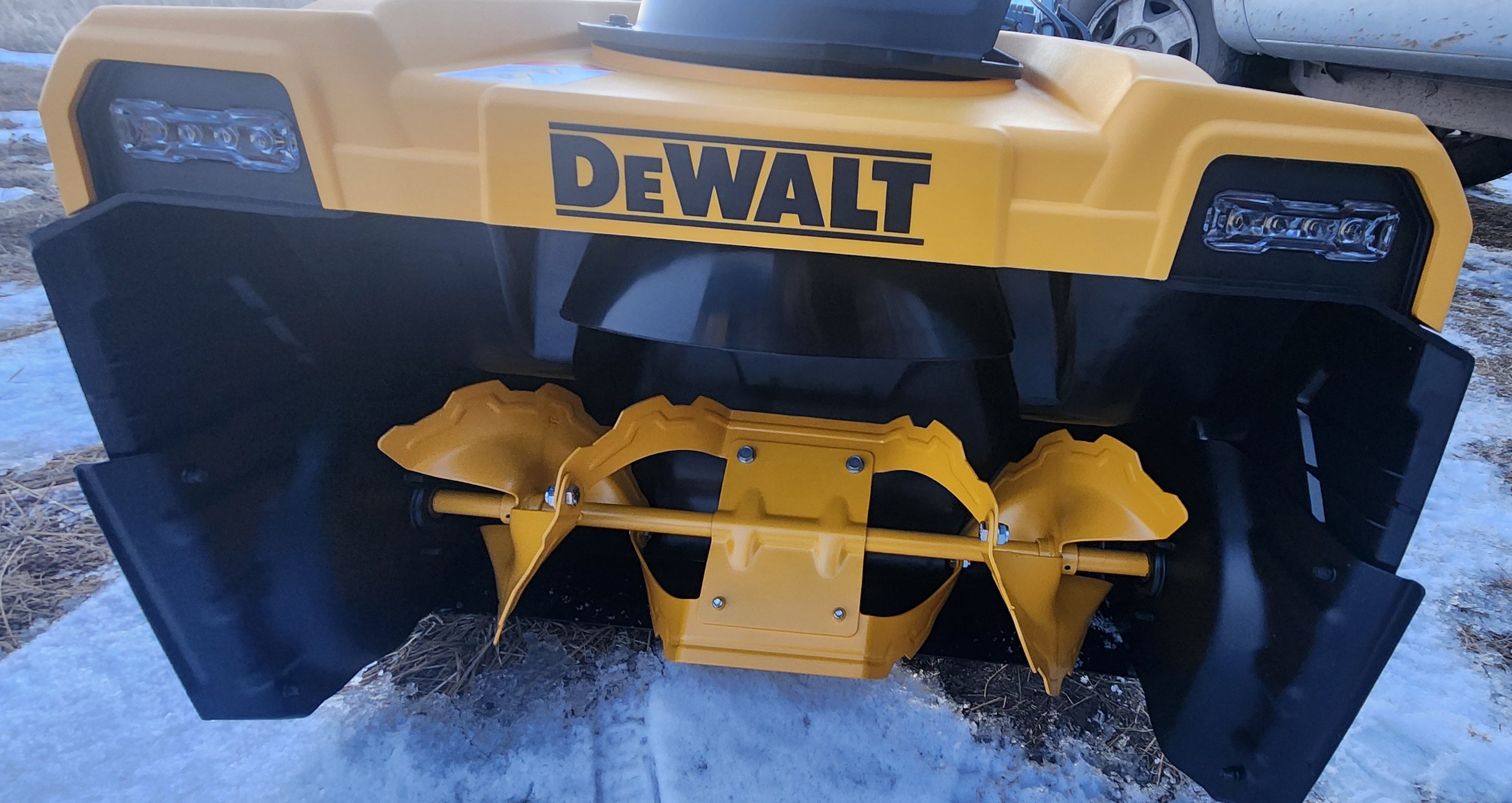
How We Tested the Best Electric Snow Blowers
We tested the snow blowers in several phases, working through a variety of conditions. In our initial test, we ran each unit through walkways, decks, and driveways where snow was several days old. With 3 to 5 inches of crusted snow on the pathways and another 8 inches piled by snow plows on the road, the test was excellent for determining blade strength in crusted and icy conditions.
The second test occurred during a massive storm in the Lake Tahoe region. Initially, we cleared several large driveways with 6 inches of fresh powder. Later that evening, the snow turned to rain and then sleet, and we were able to test the snow blowers in very wet snow conditions with 6 inches of accumulation. After we cleared the wet snow, another foot of heavy powder accumulated, giving us one more round of clearing.
It continued to snow all night, leaving another 1 to 2 feet of fresh snow in the morning. Since this was again too much for even the best snow shovel, we used the snow blowers to clear several large driveways along with pathways and decks. This test pushed the limits of deep snow and really showed the snow blowers’ capabilities. In yet another, we worked through a series of small to moderate snow storms with extreme cold conditions in Montana. The cold weather was great for determining the batteries’ abilities, and this setting even allowed us to test the machines on gravel surfaces.
What to Consider When Choosing an Electric Snow Blower
As confirmed by our tests, the best snow blowers have adjustable chutes, powerful auger blades, substantial throwing distance, and a bottom blade that scrapes through snow and ice are the most effective. But those are the only things to consider when shopping for a new snow blower: Remember to also look for an option that’s lightweight, quiet, and relatively maintenance free.
Corded vs. Cordless
- Cordless snow blowers offer the most convenience and ease of use. Like corded electric models, they start with the push of a button but aren’t limited by the constraints of a power cord. The compromise is with power and runtime.
- Corded snow blowers have access to a steady stream of 120V power, which makes them more powerful than cordless models, the beefiest of which still only use 80V batteries. Corded models also have a constant supply of power, whereas battery-powered snow blowers will work for only about 45 minutes before needing a recharge.
Type
Snow blowers fall into one of three categories: single-stage, two-stage, or three-stage blowers.
- Single-stage snow blowers, the most commonly used type for residential purposes, have a horizontal auger at the front of the machine that rotates rapidly to scoop up snow and throw it 15 to 25 feet through the chute. One disadvantage of a single-stage snow blower, however, is that it isn’t suitable for gravel driveways. Its auger blades are too low to the ground and will pick up the rocks and throw them.
- Two-stage snow blowers use an auger to scoop and throw snow, as do single-stage snow blowers, but they also have an impeller fan that makes them more effective at managing larger amounts of snow. They can throw snow more than 35 feet, and their auger blades sit high enough to clear gravel driveways.
- Three-stage snow blowers are generally only used in commercial and industrial settings. With an auger, an impeller fan, and an accelerator that grinds chunks of ice and hard-packed snow, these are powerful pieces of equipment that can throw snow up to 50 feet. However, the cost of these heavy-duty machines is higher than that of single- and two-stage models (though likely still less than paying for snow removal over the long run).
Clearing Width and Depth
When calculating clearing width and depth, think about the driveway, sidewalk, and any other areas around the home that must be cleared of snow. Some battery-powered snow blowers or throwers have small intake ports that can clear 6 inches of snow, while other models have deep 12-inch intake ports.
Given that snow is being collected and thrown continuously with these models, a nonstick spray for snow blower chutes and mouths might be a good investment to keep clumps and ice from solidifying. When fully functional, the clearing width correlates to a blower’s number of stages.
- Single-stage snow blowers are usually sufficient for residential snow removal. Use a single-stage blower to remove snow in sections 11 to 22 inches wide.
- Two-stage snow blowers, well suited for small commercial locations or large residential properties, have clearing widths between 20 and 30 inches.
- Three-stage snow blowers are used for commercial and industrial applications. They have a wide intake that can clear widths of 30 inches to more than 40 inches.
Speed and Chute Control
Because snow blowers can be heavy and cumbersome to maneuver, many users want a self-propelled model, which is fairly common in battery-powered models. Electric snow blowers also often have a variable-speed auger to speed up snow removal. Increasing the speed at which the snow is scooped and thrown through the chute makes it easier to move the machine through a light snowfall. However, a variable-speed auger isn’t as effective when clearing heavy, packed snow.
Snow blower chutes are curved, hollow tubes that extend from the back of the intake and provide a route for the snow to be thrown from the machine. On most blowers, a manual crank or lever allows you to change the angle and direction of the snow being displaced. Premium snow blowers have auto-rotating chutes that turn with the push of a button so you don’t have to stop the machine. The angle on some chutes also can be changed to allow the snow blower to throw snow even farther.
Wheels vs. Tracks
Snow blowers move via either wheels or tracks. Wheeled models feature two large rear wheels that drive the snow blower forward. Tracked models have tracks similar to those found on a tank. The tracks typically have a slip-resistant covering that’s suitable for both paved and unpaved surfaces.
Tracked snow blowers provide significantly better traction in the snow, making them better able to climb steep slopes without slipping backward. Most tracked snow blowers are two- and three-stage models, as single-stage models typically don’t produce enough power to drive the tracks. They also operate more closely to the surface, leaving a thinner layer of snow and ice on a driveway or sidewalk than wheeled models.
In comparison, wheeled snow blowers are easier to turn, as tracked models won’t pivot. Wheel sizes for single-stage snow blowers range from 6 to 8 inches. Larger wheels perform better in deeper snow, but smaller wheels are easier to maneuver. Additionally, wheeled models are generally faster than tracked models. That said, some higher-end tracked snow blowers offer faster speed and turn-on-a-dime technology that makes them comparable in speed and maneuverability to wheeled models.
The type of terrain also impacts which of these options is best for different users. Paved surfaces, such as driveways and sidewalks, are best suited for wheeled snow blowers. Tracked snow blowers are better suited for unpaved surfaces. Grade also has a significant impact, as steep driveways require a snow blower with good traction and enough power to pull it up a snow-covered slope.
Additional Features
Some of the best electric snow blowers boast special features designed to make snow clearing an easier and more comfortable endeavor.
- Heated handles may seem luxurious, but personal safety is an important part of working outdoors in freezing temperatures. The heat generated by the handles not only helps keep the user’s fingertips warm in the cold air, but it also makes it easier to hold and control the snow blower.
- A drift cutter helps clear deep drifts of snow. The cutter’s metal housing collects and pushes snow down into the auger for removal.
- Headlights make it easier to clear snow in dim lighting.
- An automatic safety shutoff switches off the snow blower when the user releases the handle.
FAQs
Though you’ve now studied the features and benefits of these tools, you might still have some lingering questions. The following questions are among those that electric snow blower buyers ask most often.Single-stage snow blowers will typically last for as long as 10 years while two-and three-stage blowers will typically have a lifespan of 15 to 25 years.
It is recommended to use a snow blower during or near the end of a heavy snowfall to prevent large amounts of snow from sticking to the ground.
Single-stage snow blowers will typically last for as long as 10 years while two-and three-stage blowers will typically have a lifespan of 15 to 25 years.
The most expensive snow blower we tested for this guide cost nearly $1600. If you’re looking for a cheap snow blower, the least expensive option to make our list was only $200.
According to Chris Ramos, representative for Blain’s Farm & Fleet, electric snow blowers are low maintenance. “Unlike gas models, there’s no need for oil changes, spark plug replacements, or dealing with fuel.” However, he also notes that “It’s still a good idea to clean the machine after use and inspect the power cord or battery regularly.” (See our guide on how to maintain a snow blower for tips on caring for other types of these tools.)
As with electric snow shovels, it’s best to store electric snow blowers in a garage, shed, or storage unit during the winter. If you need to store your machine outdoors, be sure to at least bring its battery into an above-freezing space and cover the snow blower itself with a heavy tarp.
Chris Ramos, of Blain’s Farm & Fleet, notes that the convenience of electric models is another of their advantages. “They don’t require any warm-up time like gas-powered machines. You can just plug them in or power them on and start clearing snow immediately, making the task quicker and more efficient.”
Meet the Tester
Bob Vila writer Zach Lazzari regularly covers travel, outdoor, and home improvement. When he isn’t pecking at the keyboard, Zach enjoys testing the limits of new products and traveling with his dog, Shale.
Additional research was conducted by Mike Bruton and Tony Carrick.
